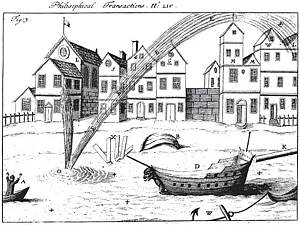
Topsham's Water Spout
Page added 15 August 2012
Back to historic events in Exeter
Among the many odd stories about Exeter that have been recorded in journals, newspapers and letters, over the years, the story of the Topsham Water Spout has been forgotten. In a letter from the archives of a certain Canadian university, can be found this event as recorded and explained by a Mr Zachary Mayne in 1694.
Zachary Mayne starts his letter by stating that he has taken 'pains to get the best information available', indicating that he had not witnessed the event himself. He then goes on to explain they are 'elevations of water during storms and tempests reaching from the superficies of the sea and clouds. They happen several ways, sometimes the water is seen to boyl, and raise it self for a considerable space round about a foot from the surface, above which appears, as it were, a tick and black smoak, in the midst of which is observed a sort of stream or pipe resembling a tunnel, which ariseth as high as the clouds; at other times these pipes or tunnels are observed to come from the clouds, and suck up the water with great noise and violence'. He then goes on to explain how they can lift sand and stone.
So what of this water spout at Topsham? On Tuesday 7th August 1694, between nine and ten in the morning, at low water, the spout appeared, sucking up water from the channel at Topsham. The spout moved with the wind, looking like a column of dark smoke.
Mayne supplied a detailed diagram of the spout which was annotated to show different aspects of the event. The +++ indicate the River Exe channel and O indicates the spout (see right). The house of an eye witness, Mr Seaward, marked S, was 'gently touched with little or no damage' and only removing a few tiles. The house of Widow Goldsworthy, marked G, lost almost all its thatch on the wall and a large limb on a plumb tree in the garden. An apple tree which had a trunk about 15 inches thick, was snapped off near the ground and thrown 20 to thirty feet.
Mr Green's house, marked G, lost most of its tiles and a linney (lean to shed) was damaged. The wall of two houses marked W L were badly damaged, and yet, strangely, the house between, marked MM, belonging to Mr Moxam suffered only a couple of broken windows.
The progress of the water spout is marked with EEEEE and X is the planks that were blown about. A newly built ship, of a hundred tons, anchored in the channel marked D, was 'shaken, but not hurt.' A ship's mast weighing a ton, marked K was thrown about, and an anchor, marked W was 'torn out of the ground, and carried seven or eight foot with a boat that was fastened to it, and blown up into the air, that boat was rent from the head to the keel.' Another boat, marked B was blown six feet into the air and turned upside down. A fisherman, in a boat nearby, escaped injury.
The water spout divided, and one section then moved up a lane on the left, marked LA, damaging more house on its way.
Zacahry Mayne then concludes his report on what must have been an extraordinary event for the folk of Topsham with "..'Tis no small Mercy that no Man, Woman, or Child received the least injury in their Persons. God shews us what he can do, happy we, if we understood his meaning, and comply with it; but alas, Mercies and Judgements are soon forgotten."
This is the earliest water spout I have found recorded at Exeter. However, in 1850 a water spout hit the Port Royal on St Leonard's quay, and the Shilhay Hurricane, in the 1920s, was described by Cyril Brown.
│ Top of Page │
